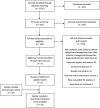Effectiveness of meatal cleaning in the prevention of catheter-associated urinary tract infections and bacteriuria: an updated systematic review and meta-analysis
- PMID: 34103320
- PMCID: PMC8190044
- DOI: 10.1136/bmjopen-2020-046817
Effectiveness of meatal cleaning in the prevention of catheter-associated urinary tract infections and bacteriuria: an updated systematic review and meta-analysis
Abstract
Objective: A systematic review on meatal cleaning prior to urinary catheterisation and post catheterisation and reduces the risk catheter-associated urinary tract infections (CAUTIs) and bacteriuria was published in 2017, with further studies undertaken since this time. The objective of this paper is to present an updated systematic review on the effectiveness of antiseptic cleaning of the meatal area for the prevention of CAUTIs and bacteriuria in patients who receive a urinary catheter.
Design: Systematic review.
Data sources: Electronic databases Cochrane Library, PubMed, Embase, The Cumulative Index to Nursing and Allied Health Literature (CINAHL), Medline and Academic Search Complete were searched from 1 January 2016 and 29 February 2020.
Eligibility criteria: Randomised controlled trials (RCTs) and quasi-experimental studies evaluating the use of antiseptic, antibacterial or non-medicated agents for cleaning the meatal, periurethral or perineal areas before indwelling catheter insertion or intermittent catheterisation or during routine meatal care.
Data extraction and synthesis: Data were extracted using the Cochrane Collaboration's data collection form for RCTs and non-RCTs. Data were extracted by one researcher and then checked for accuracy by a second researcher.
Results: A total of 18 studies were included. Some potential benefit of using antiseptics, compared with non-antiseptics for meatal cleaning to prevent bacteriuria and or CAUTI was identified (OR 0.84, 95% CI 0.69 to 1.02; p=0.071). Antiseptics (chlorhexidine or povidine-iodine) may be of value for meatal cleaning on the incidence of CAUTI, compared with comparator agents (saline, soap or antimicrobial cloths) (OR=0.65, 95% CI 0.42 to 0.99; p=0.047).
Conclusion: There is emerging evidence of the role of some specific antiseptics (chlorhexidine) prior to urinary catheterisation, in reducing CAUTIs, and some potential benefit to the role of antiseptics more generally in reducing bacteriuria.
Prospero registration number: CRD42015023741.
Keywords: infection control; preventive medicine; quality in health care; urinary tract infections.
© Author(s) (or their employer(s)) 2021. Re-use permitted under CC BY-NC. No commercial re-use. See rights and permissions. Published by BMJ.
Conflict of interest statement
Competing interests: BM reports personal fees from MSD, grants from Cardinal Health, grants from Senver, outside the submitted work.
Figures





References
Publication types
MeSH terms
Substances
LinkOut - more resources
Full Text Sources
Medical
